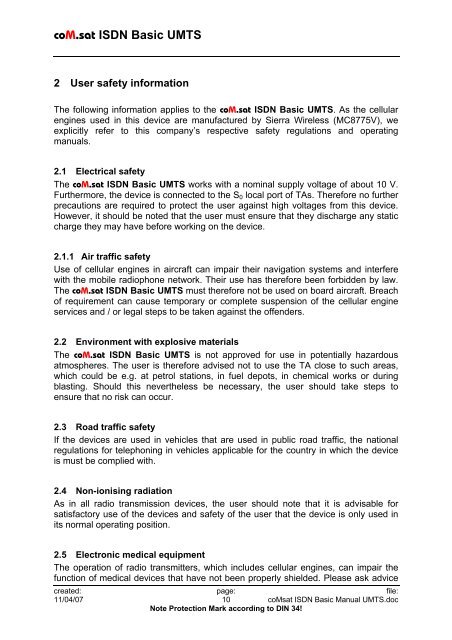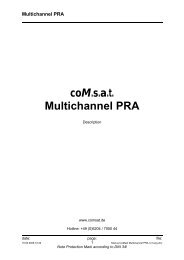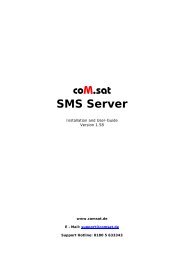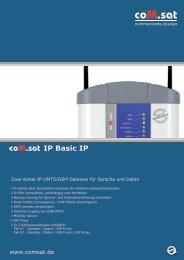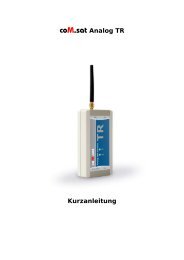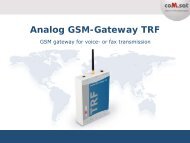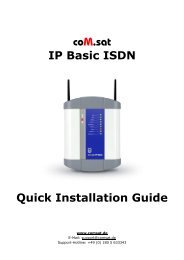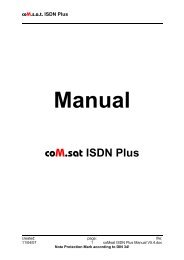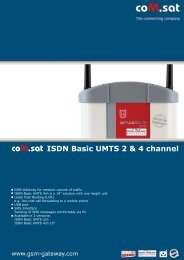coM.sat ISDN Basic UMTS
coM.sat ISDN Basic UMTS
coM.sat ISDN Basic UMTS
You also want an ePaper? Increase the reach of your titles
YUMPU automatically turns print PDFs into web optimized ePapers that Google loves.
<strong>coM</strong>.<strong>sat</strong> <strong>ISDN</strong> <strong>Basic</strong> <strong>UMTS</strong><br />
2 User safety information<br />
The following information applies to the <strong>coM</strong>.<strong>sat</strong> <strong>ISDN</strong> <strong>Basic</strong> <strong>UMTS</strong>. As the cellular<br />
engines used in this device are manufactured by Sierra Wireless (MC8775V), we<br />
explicitly refer to this company’s respective safety regulations and operating<br />
manuals.<br />
2.1 Electrical safety<br />
The <strong>coM</strong>.<strong>sat</strong> <strong>ISDN</strong> <strong>Basic</strong> <strong>UMTS</strong> works with a nominal supply voltage of about 10 V.<br />
Furthermore, the device is connected to the S0 local port of TAs. Therefore no further<br />
precautions are required to protect the user against high voltages from this device.<br />
However, it should be noted that the user must ensure that they discharge any static<br />
charge they may have before working on the device.<br />
2.1.1 Air traffic safety<br />
Use of cellular engines in aircraft can impair their navigation systems and interfere<br />
with the mobile radiophone network. Their use has therefore been forbidden by law.<br />
The <strong>coM</strong>.<strong>sat</strong> <strong>ISDN</strong> <strong>Basic</strong> <strong>UMTS</strong> must therefore not be used on board aircraft. Breach<br />
of requirement can cause temporary or complete suspension of the cellular engine<br />
services and / or legal steps to be taken against the offenders.<br />
2.2 Environment with explosive materials<br />
The <strong>coM</strong>.<strong>sat</strong> <strong>ISDN</strong> <strong>Basic</strong> <strong>UMTS</strong> is not approved for use in potentially hazardous<br />
atmospheres. The user is therefore advised not to use the TA close to such areas,<br />
which could be e.g. at petrol stations, in fuel depots, in chemical works or during<br />
blasting. Should this nevertheless be necessary, the user should take steps to<br />
ensure that no risk can occur.<br />
2.3 Road traffic safety<br />
If the devices are used in vehicles that are used in public road traffic, the national<br />
regulations for telephoning in vehicles applicable for the country in which the device<br />
is must be complied with.<br />
2.4 Non-ionising radiation<br />
As in all radio transmission devices, the user should note that it is advisable for<br />
<strong>sat</strong>isfactory use of the devices and safety of the user that the device is only used in<br />
its normal operating position.<br />
2.5 Electronic medical equipment<br />
The operation of radio transmitters, which includes cellular engines, can impair the<br />
function of medical devices that have not been properly shielded. Please ask advice<br />
created: page: file:<br />
11/04/07 10 <strong>coM</strong><strong>sat</strong> <strong>ISDN</strong> <strong>Basic</strong> Manual <strong>UMTS</strong>.doc<br />
Note Protection Mark according to DIN 34!


